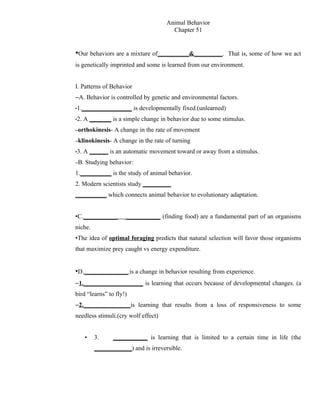
Chapter 51
- 1. Animal Behavior Chapter 51 •Our behaviors are a mixture of__________&_________. That is, some of how we act is genetically imprinted and some is learned from our environment. I. Patterns of Behavior –A. Behavior is controlled by genetic and environmental factors. •1.________________ is developmentally fixed.(unlearned) •2. A _______ is a simple change in behavior due to some stimulus. –orthokinesis- A change in the rate of movement –klinokinesis- A change in the rate of turning •3. A ______ is an automatic movement toward or away from a stimulus. –B. Studying behavior: 1.__________ is the study of animal behavior. 2. Modern scientists study _________ __________ which connects animal behavior to evolutionary adaptation. •C.___________ ___________ (finding food) are a fundamental part of an organisms niche. •The idea of optimal foraging predicts that natural selection will favor those organisms that maximize prey caught vs energy expenditure. •D.______________ is a change in behavior resulting from experience. –1.___________________ is learning that occurs because of developmental changes. (a bird “learns” to fly!) –2._______________is learning that results from a loss of responsiveness to some needless stimuli.(cry wolf effect) • 3. ___________ is learning that is limited to a certain time in life (the ____________) and is irreversible.
- 2. E. Ways animals learn: •1.______________________ is the ability to associate one stimulus with another. a.___________________ -stimulus is associated with a reward or punishment. (Pavlov’s dogs) b.___________________ occurs as an organism begins to associate a behavior with a reward or punishment. F. _________________ may serve as learning experiences for the young. –G. ________________ is the ability to perceive, store and process information. The warning call of the primate is given in response to a perceived threat. 1.___________________ is an example of how animals use __________________ (internal codes of the relationships among physical objects) –2. ___________________ displays support the hypothesis that other animals are cognitive, thinking individuals. •H. ________________ is any interaction between animals. •_________________________ separates animals for breeding, feeding and rearing young. •1.____________________ may involve threats or submissive behavior over resources. (usually symbolic or ritualistic) 2.________ _________ ____________ requires working together. –3.______________ are defined spaces used for feeding, mating, raising young, etc. •I. ____________________ keep every member in their place. •J. _______________________ assure the continuation of the species. 1.________ is a set of patterns that lead to mating.
- 3. 2.___________ are chemicals signals for mating. •K. Parental Investment is the _______________________________.The egg is more energy expensive, as is the gestation period for the female. Thus, she is very selective! •L. Many forms of sexual behavior exist: 1.______________ do not form pair-bonds. 2._________________animals mate with one mate for life or one season (serial monogamy) . •3. Polygamous animals mate_______________. a. ___________-one male with many females b. ______________-one female with many males. •M. ____________________ is essential to social interactions. N. _________occurs when individuals give up personal fitness for the fitness of the group. •Female ground squirrels stick close to home and are almost exclusively responsible for warning calls (to their relatives!) •______________________ is the total fitness that comes from not only having your own young, but also helping other close family members with the survival of their young.
